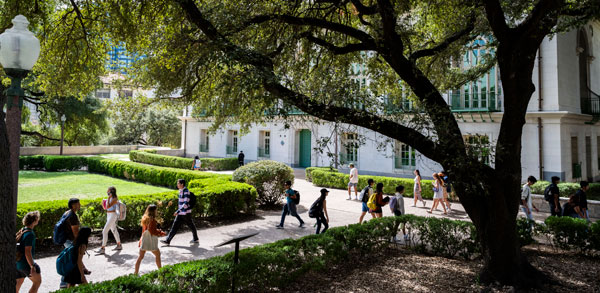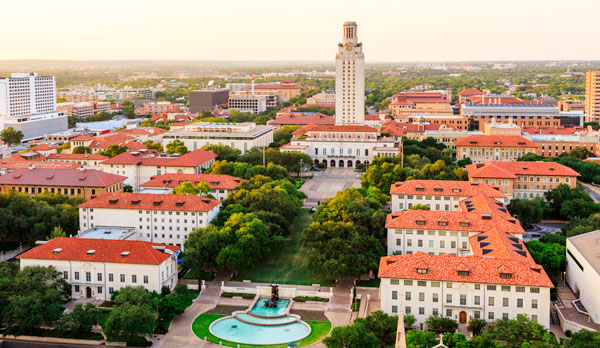Texas’ workforce won’t look the same by the end of the decade. With the Texas Higher Education Coordinating Board’s (THECB) ambitious strategic plan, Building a Talent Strong Texas, gaining momentum, the Lone Star State is on its way to ensuring that 60% of its workforce under the age of 65 attains a degree or certification by 2030.
The increasing demand for certified skill sets is an issue every state in the nation is attempting to tackle. In March, I sat down with the Commissioner of Higher Education for the State of Texas and CEO of the Texas Higher Education Coordinating Board Harrison Keller to discuss how this strategy is setting Texas apart from its competition.
“When I talk to employers across the state, what they tell me is their workforce needs are changing faster than they ever anticipated,” says Commissioner Keller. “This is a highly dynamic time, especially because of new technologies and the rapid rise of artificial intelligence. So, if we are going to be competitive, we have to have the talent ready for new kinds of jobs for new industries.”
Commissioner Keller has found that collaborations between academia and employers are essential to solving this dilemma.
“For industry, as they are sorting out what these emerging workforce needs look like, higher education can be a partner in developing new programs that are tailored to rapidly changing needs around artificial intelligence, business analytics, engineering, design.”
Multiple universities and colleges throughout Texas are already collaborating with one another to create hubs for emerging sectors and accelerate research and implementation on education methods.
“Even if we succeed in building more world-class educational programs that align with emerging workforce needs, if students can’t take advantage of those programs because of financial barriers, then we won’t have the educated workforce we need.”
— Harrison Keller, Commissioner of Higher Education for the State of Texas, CEO of the Texas Higher Education Coordinating Board
In March, The University of Texas at Austin, Austin Community College District and Texas Institute for Electronics (TIE) announced that they were collaborating to establish a joint Semiconductor Training Center (STC), allowing students at UT, ACC and across the nation to receive hands-on technical training in skills essential to the semiconductor industry. Additionally, the partnership plans to develop stackable skill-based education activities for K-12 students. As part of the ACC-UT agreement, TIE will commit approximately $3.75 million of funding that was provided by the State of Texas through the Texas CHIPS Act to develop the STC.
ACC has developed a rapid four-week upskilling program for the semiconductor industry, Semiconductor Technician Advanced Rapid Start (STARS) curriculum, in collaboration with the Austin Regional Manufacturing Association (ARMA) and leaders in the regional semiconductor industry – including Samsung Austin Semiconductor, NXP Semiconductors, Tokyo Electron, Infineon and Applied Materials.
Starting in fall 2025, UT will be introducing a new Master of Science in Engineering with a major in semiconductor science and engineering.
Two months prior to this announcement, UT also launched an artificial intelligence hub, the Center for Generative AI, powered by a new GPU computing cluster. UT is already home to the National Science Foundation-supported AI Institute for Foundations of Machine Learning (IFML) and TACC’s Frontera, the most powerful supercomputer at a U.S. university.
 University of Texas at Austin
University of Texas at Austin
Photo: Getty Images
Accessible and Affordable Opportunities
As new programs pop up throughout the state, the THECB has promptly been working on multiple initiatives to increase the number of Texans completing degree and certification programs.
Recognizing the importance of this mission, Texas lawmakers made historic investments in higher education during the last legislative session totaling more than $5 billion to be dispersed over the next two years. Last June, several of the bills that were passed focused on making postsecondary attainment more accessible and affordable.
“Even if we succeed in building more world-class educational programs that align with emerging workforce needs, if students can’t take advantage of those programs because of financial barriers, then we won’t have the educated workforce we need,” says Commissioner Keller.
Multiple scholarship programs, including the Texas Leadership Scholars initiative and the Texas First Program, received an influx of funding. Legislators also chose to prohibit undergraduate tuition and fees from increasing for both the 2023-24 and 2024-25 academic years. The affordability money was tied to tenure reform as well as legislation prohibiting diversity, equity and inclusion offices in public higher education institutions.
One of the most significant pieces of legislature from the 88th session includes House Bill 8 (HB 8), which is set to redesign the funding model for Texas’ 50 community colleges districts. Instead of measuring success based on enrollment, the new standard will reward institutions for awarding degrees and certificates in high-demand fields, students transferring to four-year universities and dual enrollment participation from high school students. It also seeks to foster transparency regarding jobs and salary prospects.
A Head Start on Higher Ed
To continue this mission of increasing the transparency and accessibility of information on jobs and education requirements, the THECB launched My Texas Future, an interactive career and program exploration platform, in August 2023.
Commissioner Keller describes the platform as a “one-stop-shop”, where students can efficiently research careers and identify in-demand, high-paying jobs and affordable higher education programs in their region. He also revealed that the THECB plans to deploy a new feature this summer that will allow users to submit applications for higher ed programs in “just a few clicks.”
“We’ve done a lot of work at the intersection of high school and higher education,” says Commissoner Keller. “As part of the legislation around community college finance, the legislature created a new financial aid program for students in dual enrollment programs that enables students who qualify for free or reduced lunch in high school to take dual enrollment courses at no cost.”
The Financial Aid for Swift Transfer (FAST) Scholarship was established through the passing of HB 8. In addition to participating in the classes free of charge, all credits earned can be transferred and applied to degree programs at any public colleges or universities in the state.
In addition to traditional dual credit classes, the THECB is gearing up to release materials for a new dual enrollment option next fall.
“These are called College Connect Courses,” says Commissioner Keller. “We’ve sponsored the development of resources by UT Austin, Texas A&M and Rice University, working in partnership with other institutions, including community colleges, to develop resources that can be deployed in dual credit courses for students that might not quite be college ready around certain topics.
“We’re excited about the potential for this work to scale,” he says, “and help many more students be competitive and college ready when they arrive on college campuses.”

